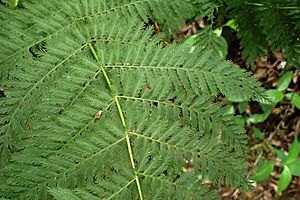Crepe fern facts for kids
Quick facts for kids Single crepe fern |
|
|---|---|
 |
|
| Scientific classification | |
| Genus: |
Leptopteris
|
| Species: |
hymenophylloides
|
The Leptopteris hymenophylloides, often called the single crepe fern, is a special type of fern. It belongs to the Osmundaceae family, which is a group of ancient ferns.
This fern is unique because it is endemic to New Zealand. This means it naturally grows only in New Zealand and nowhere else in the world!
Contents
Discovering the Single Crepe Fern
The single crepe fern is a beautiful plant that adds to New Zealand's amazing natural environment. It's known for its delicate, almost see-through leaves.
Where Does It Grow?
You can find the single crepe fern in many parts of New Zealand. It grows on both the North Island and the South Island, as well as on smaller islands like the Chatham Islands and Stewart Island / Rakiura.
North Island Locations
On the North Island, this fern is quite common. You can spot it in places like Northland, Auckland, the Volcanic Plateau, Gisborne, Taranaki, and the southern parts of the North Island. It prefers areas that are not too high up, usually from 10 to 950 meters above sea level.
South Island Locations
In the South Island, the single crepe fern is also found in many areas. Look for it in Western Nelson, the Sounds-Nelson region, Marlborough, Westland, Canterbury, Otago, and Southland, including Fiordland. It's more common in lower areas but can sometimes be found up to 925 meters high in places like inland Marlborough.
Preferred Habitat
This fern loves damp, shady places. It often grows in forests where the air is moist and the sunlight is filtered. While it's found across New Zealand, it's not very common right on the coast, especially on the east coast and in Taranaki. It also tends to avoid very high mountain areas.
Why Is It Special?
The single crepe fern is a great example of New Zealand's unique plant life. Being endemic, it's a plant that has evolved over a long time specifically in New Zealand's environment. Protecting these special plants helps keep New Zealand's ecosystems healthy and unique.

